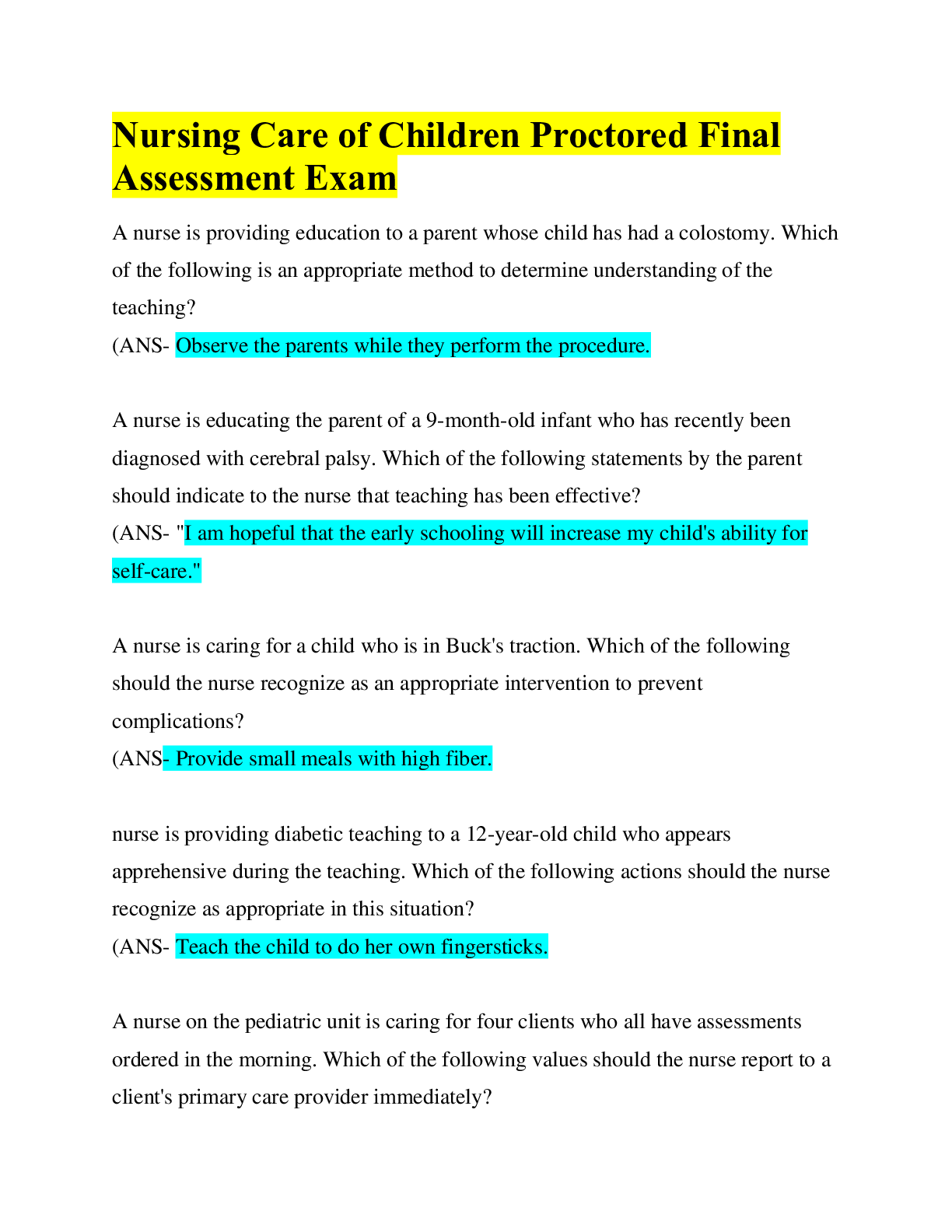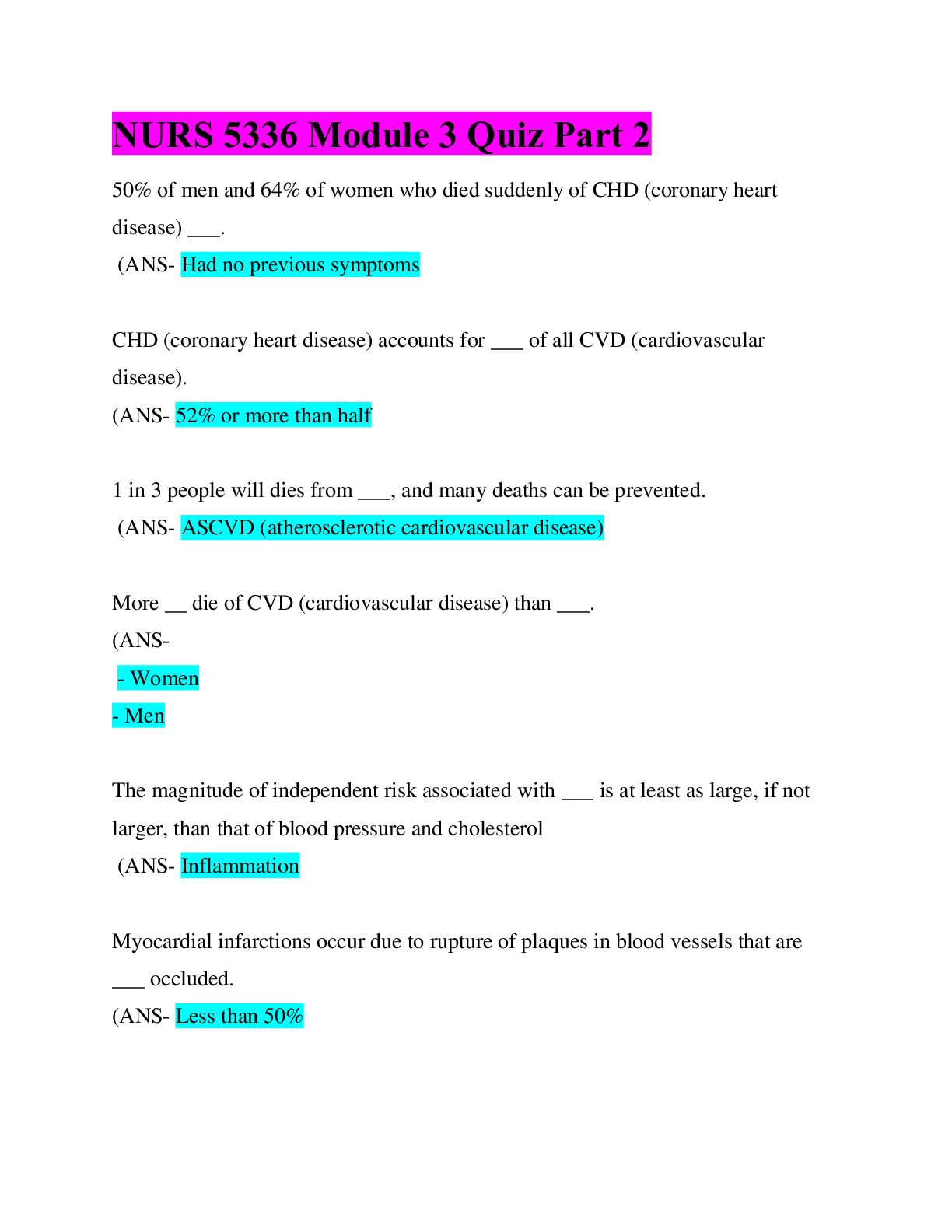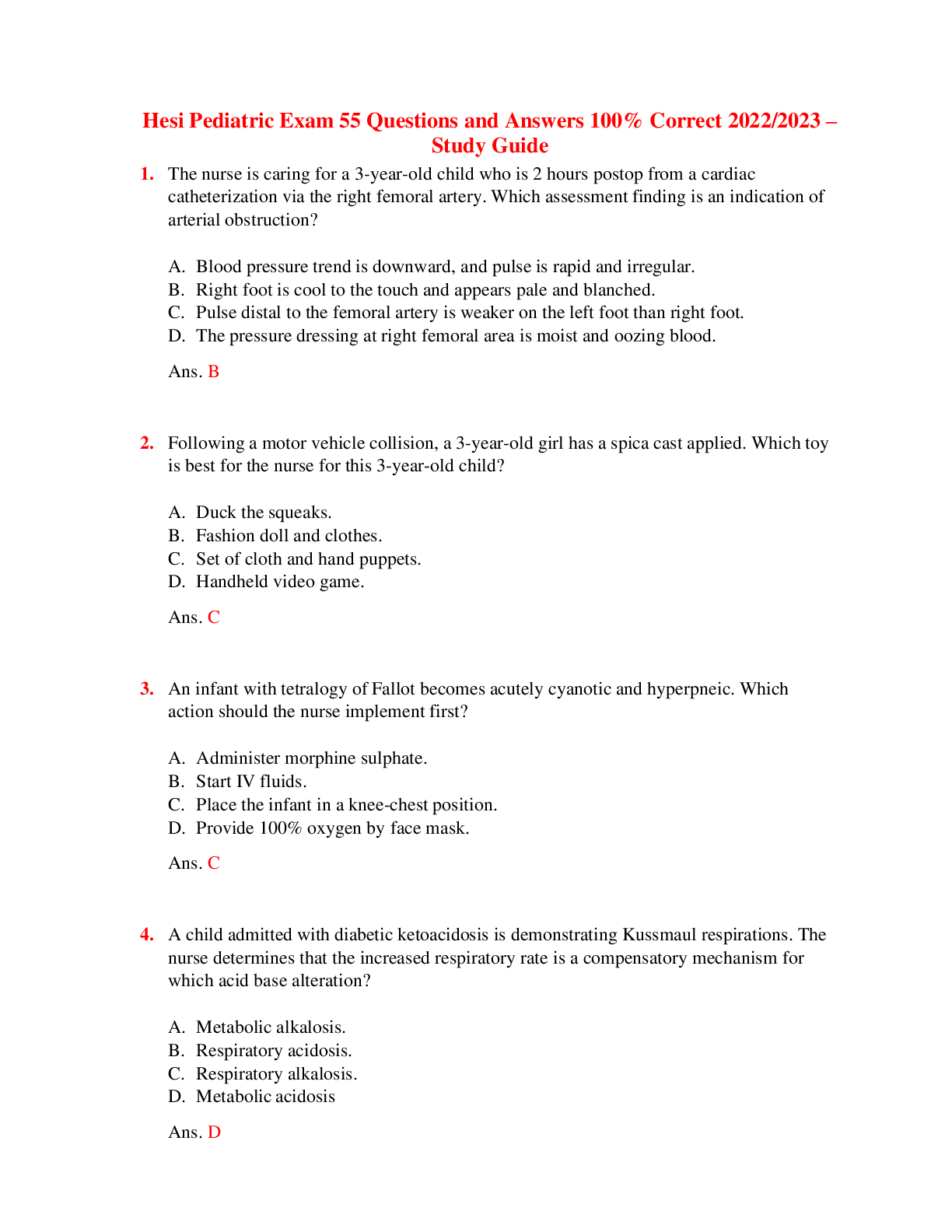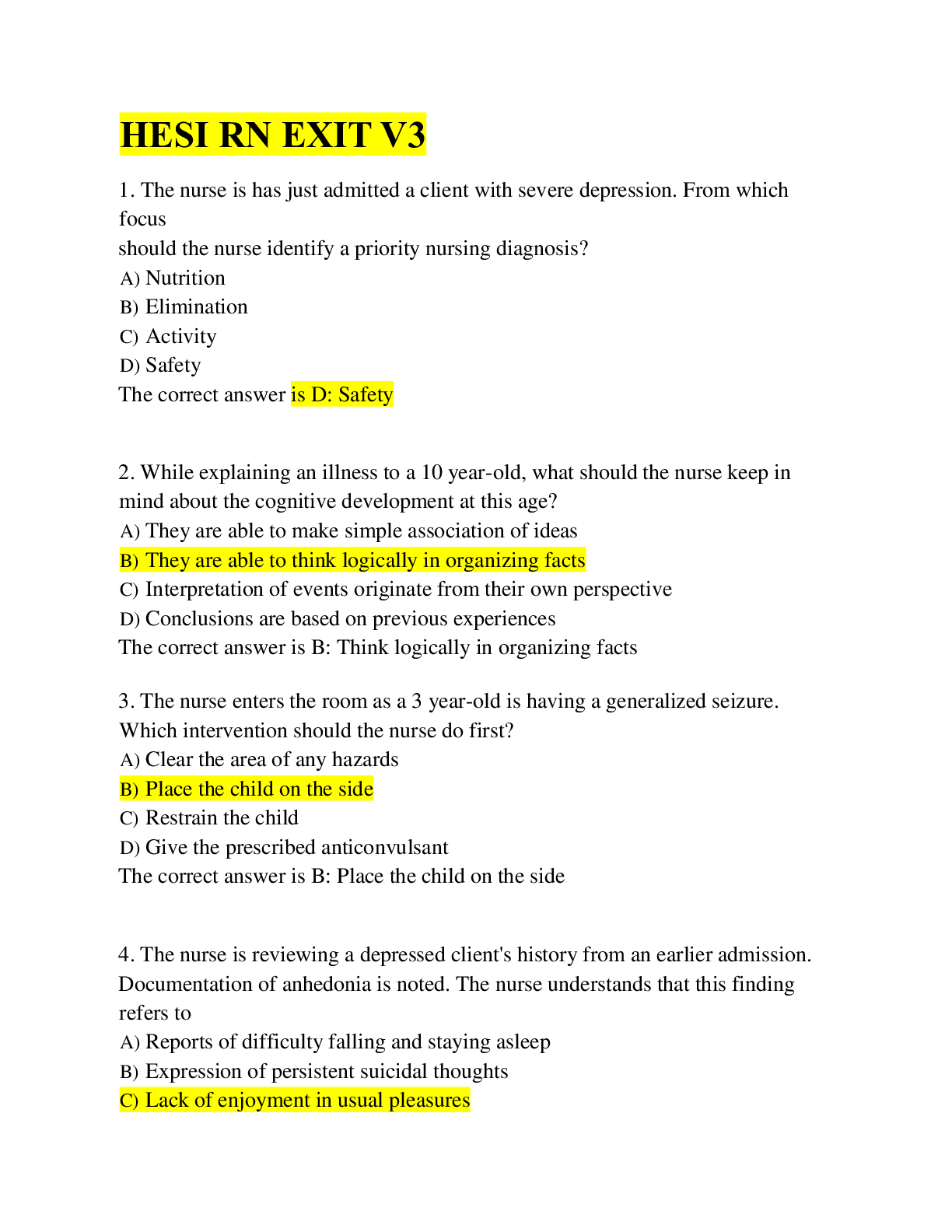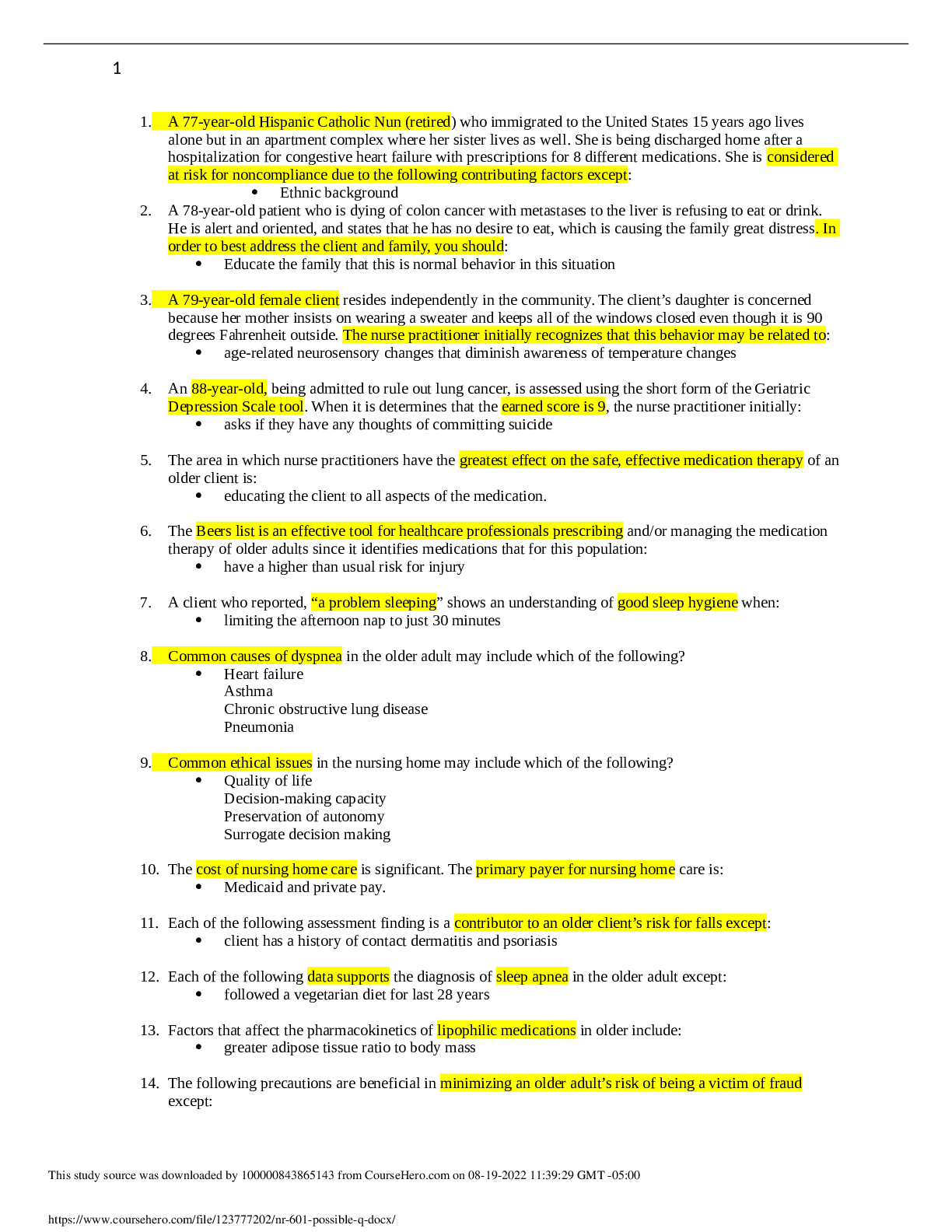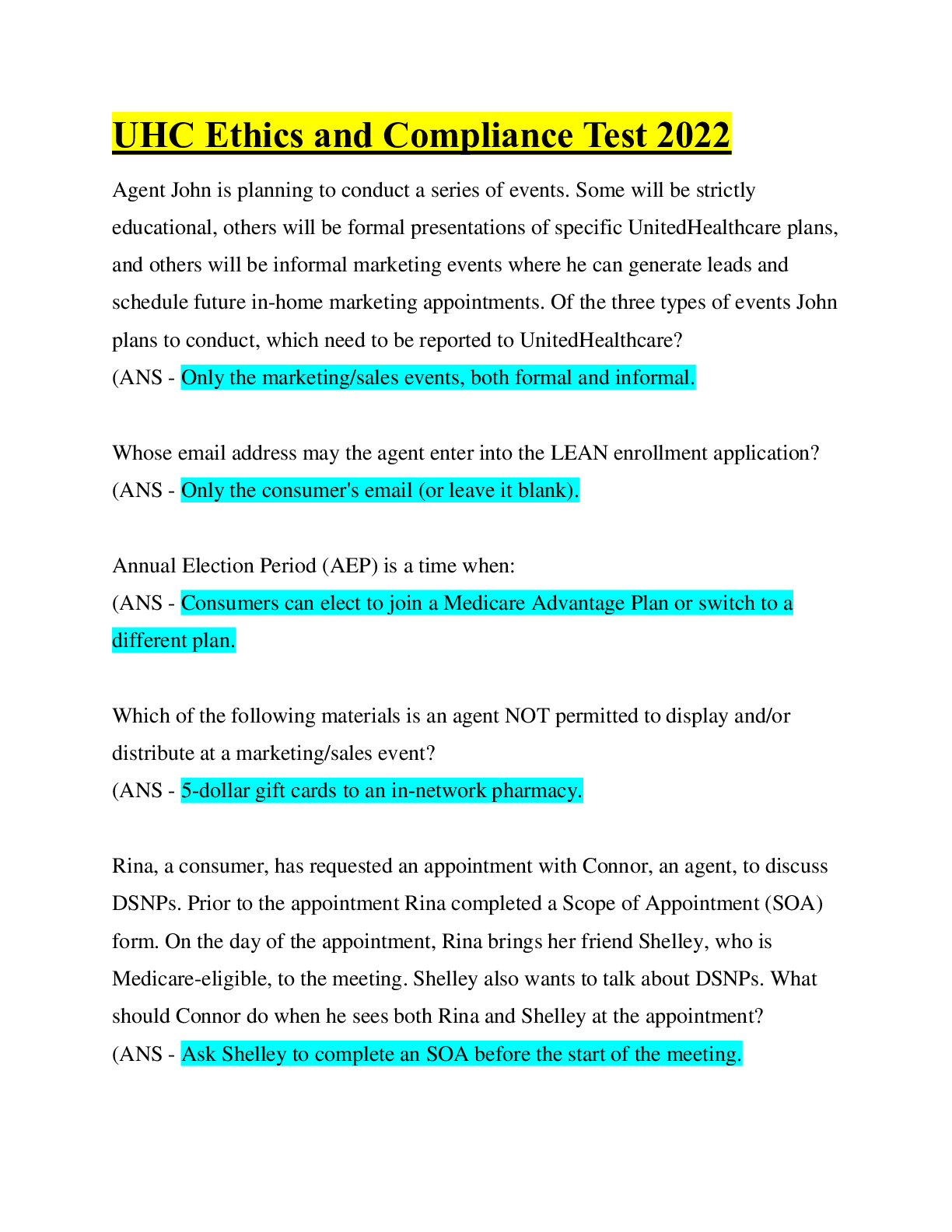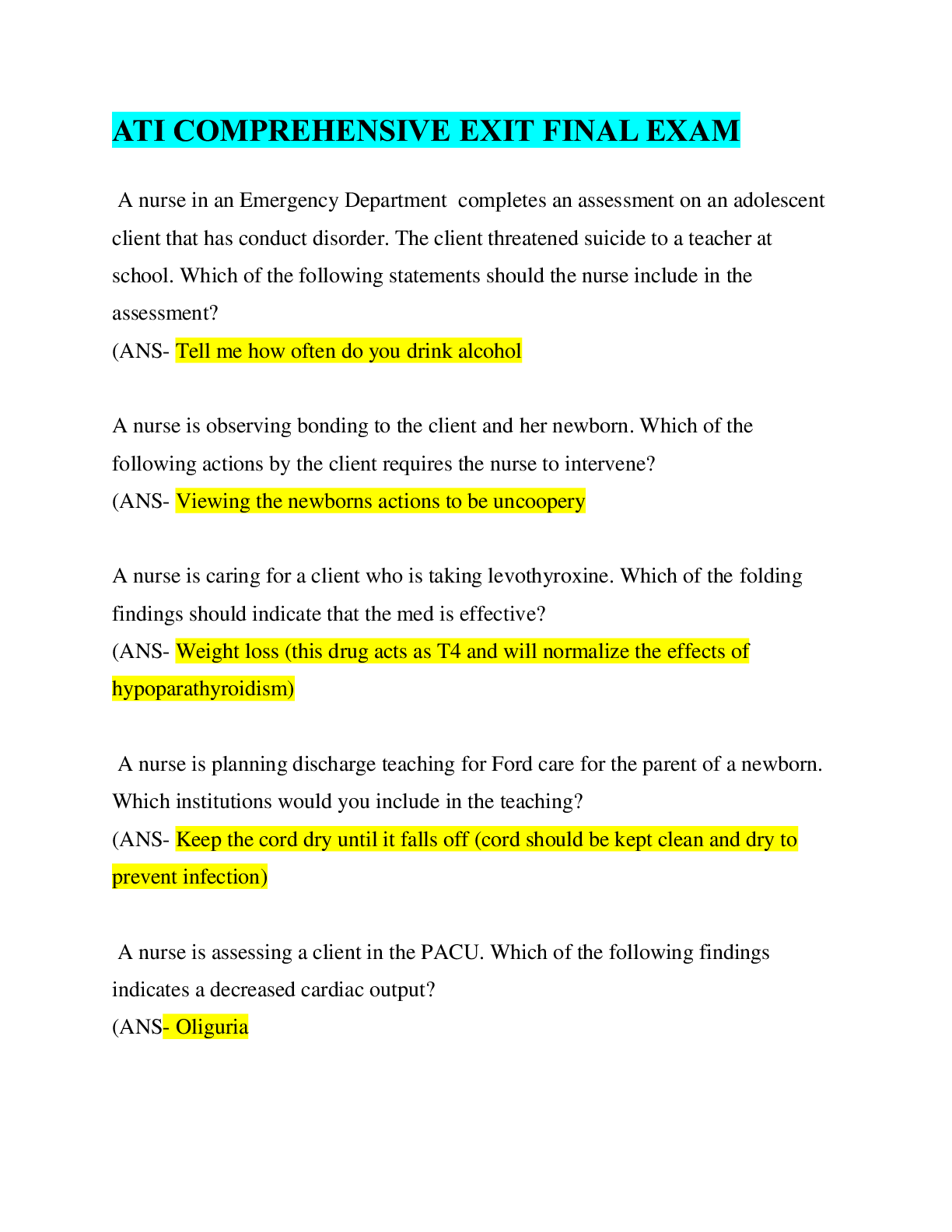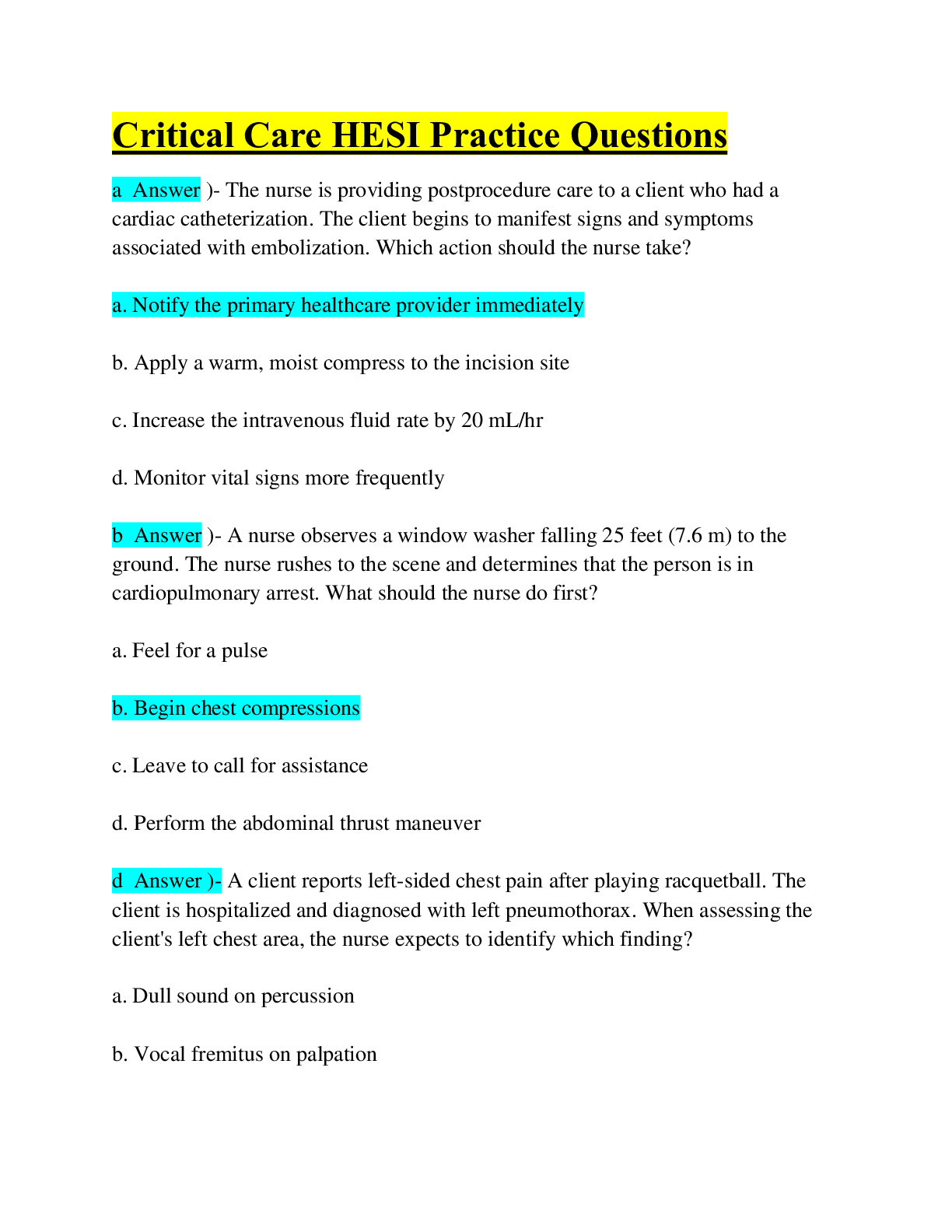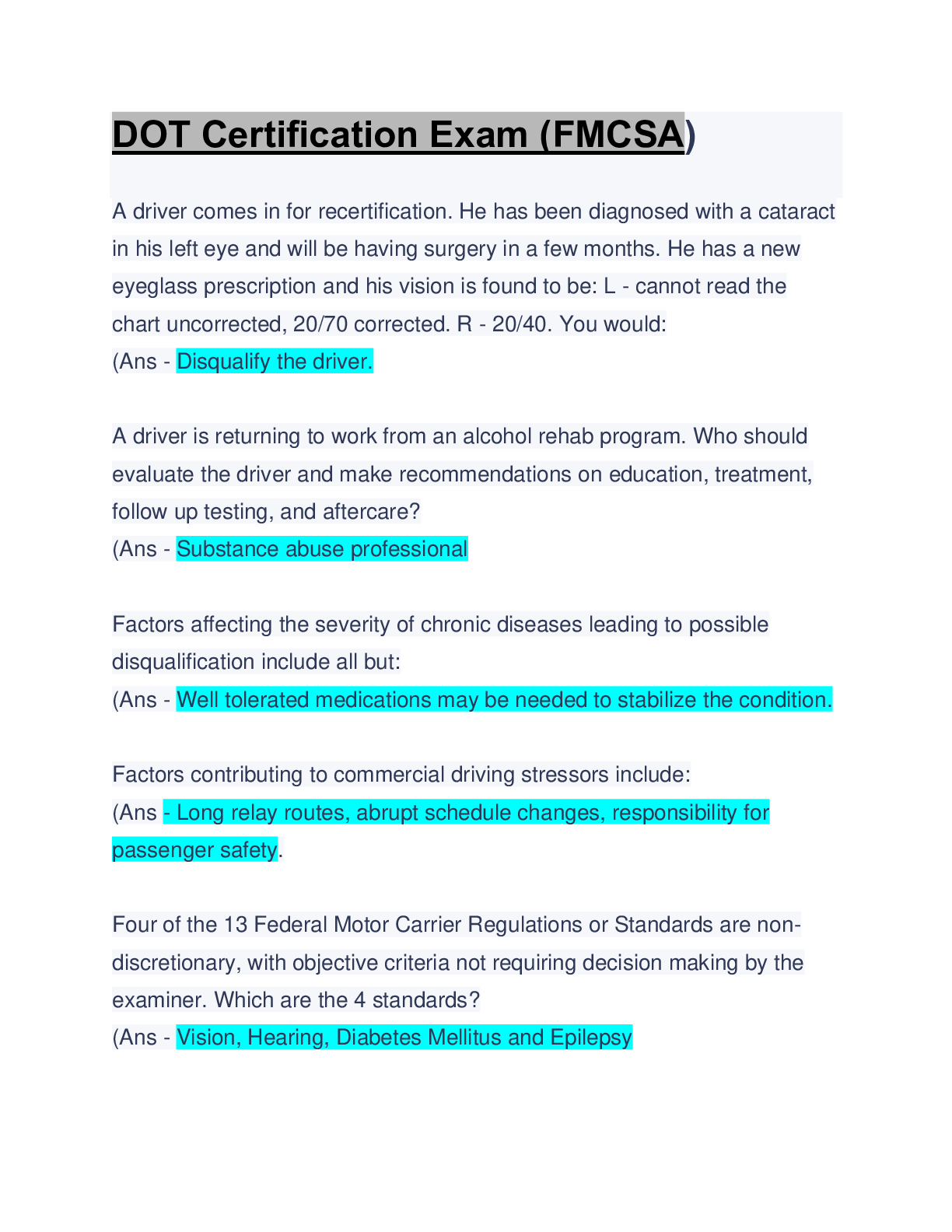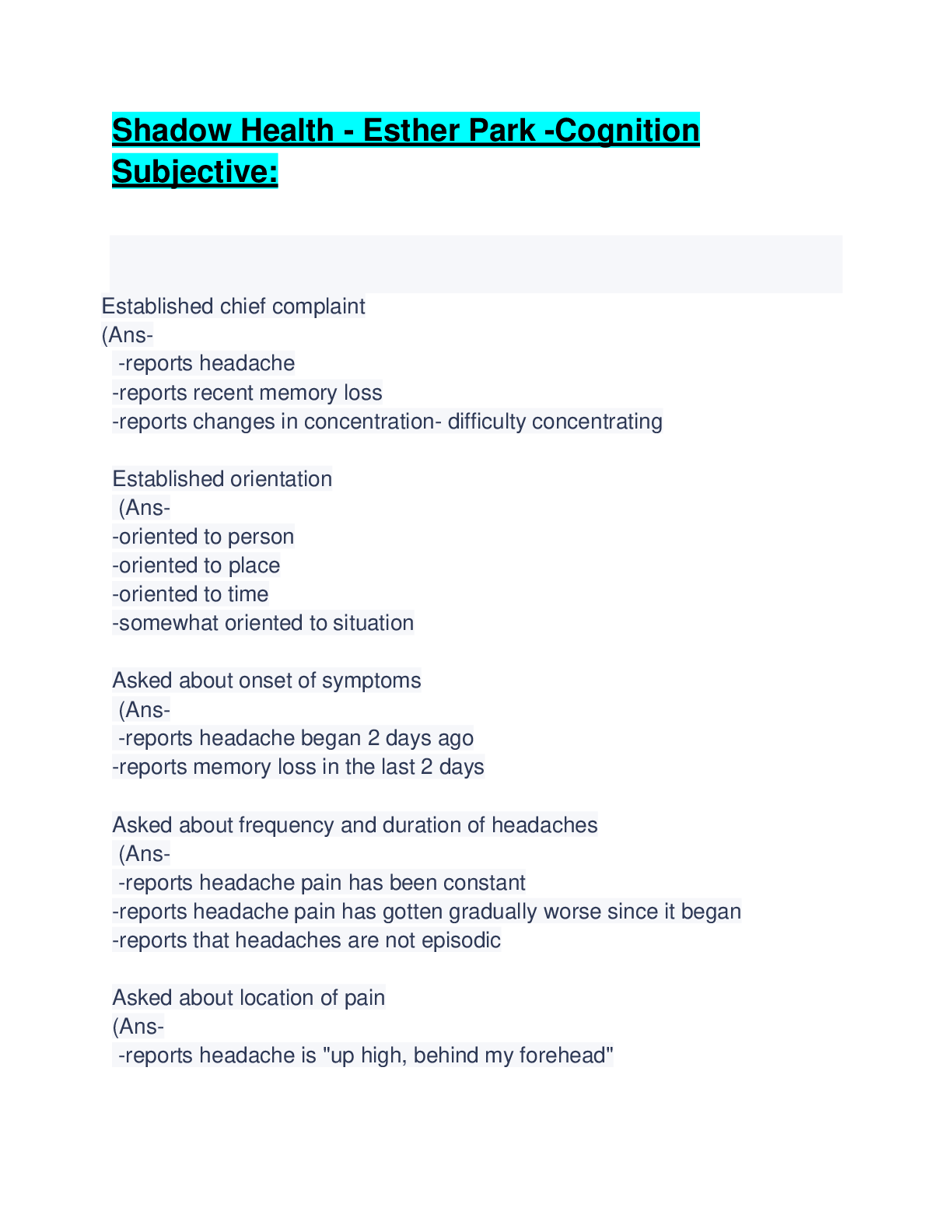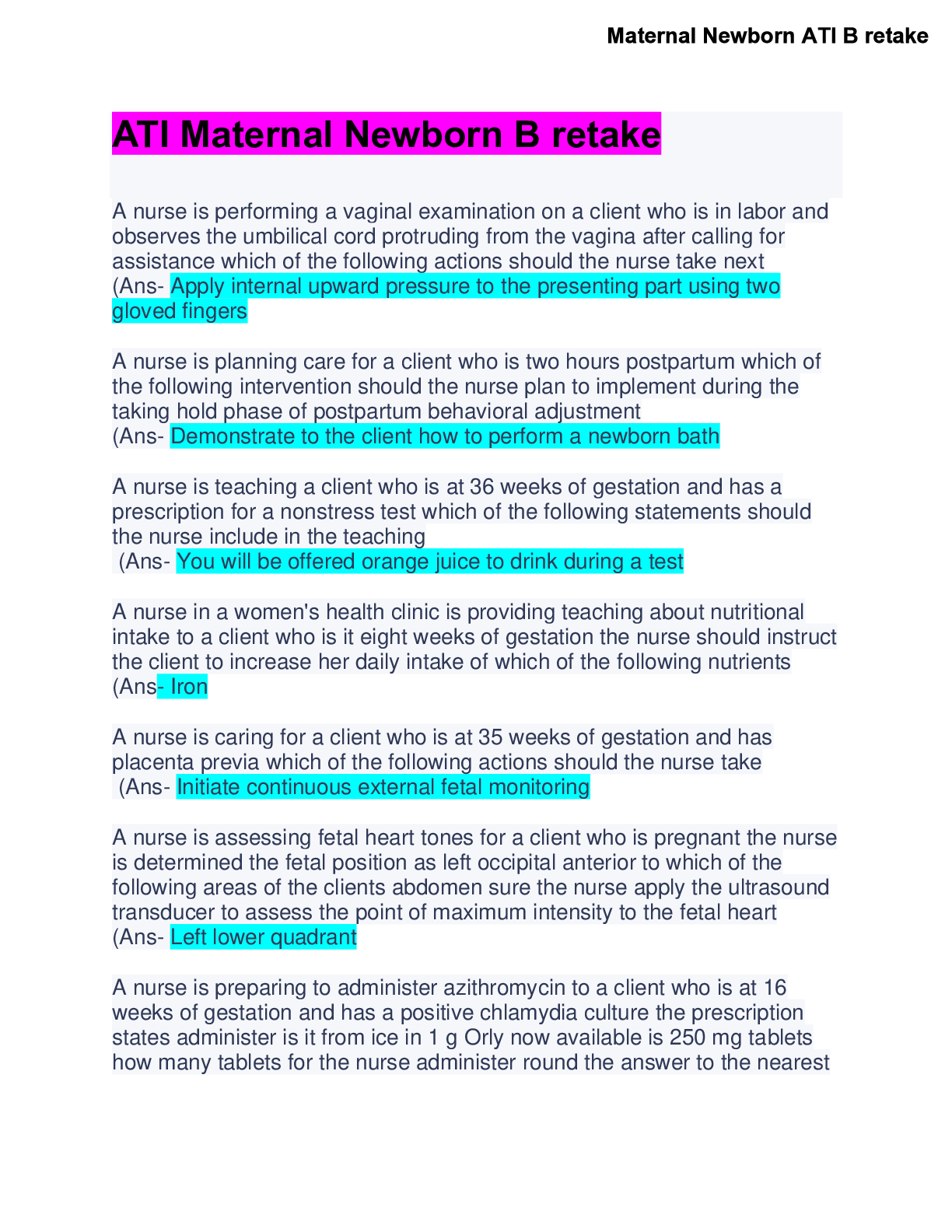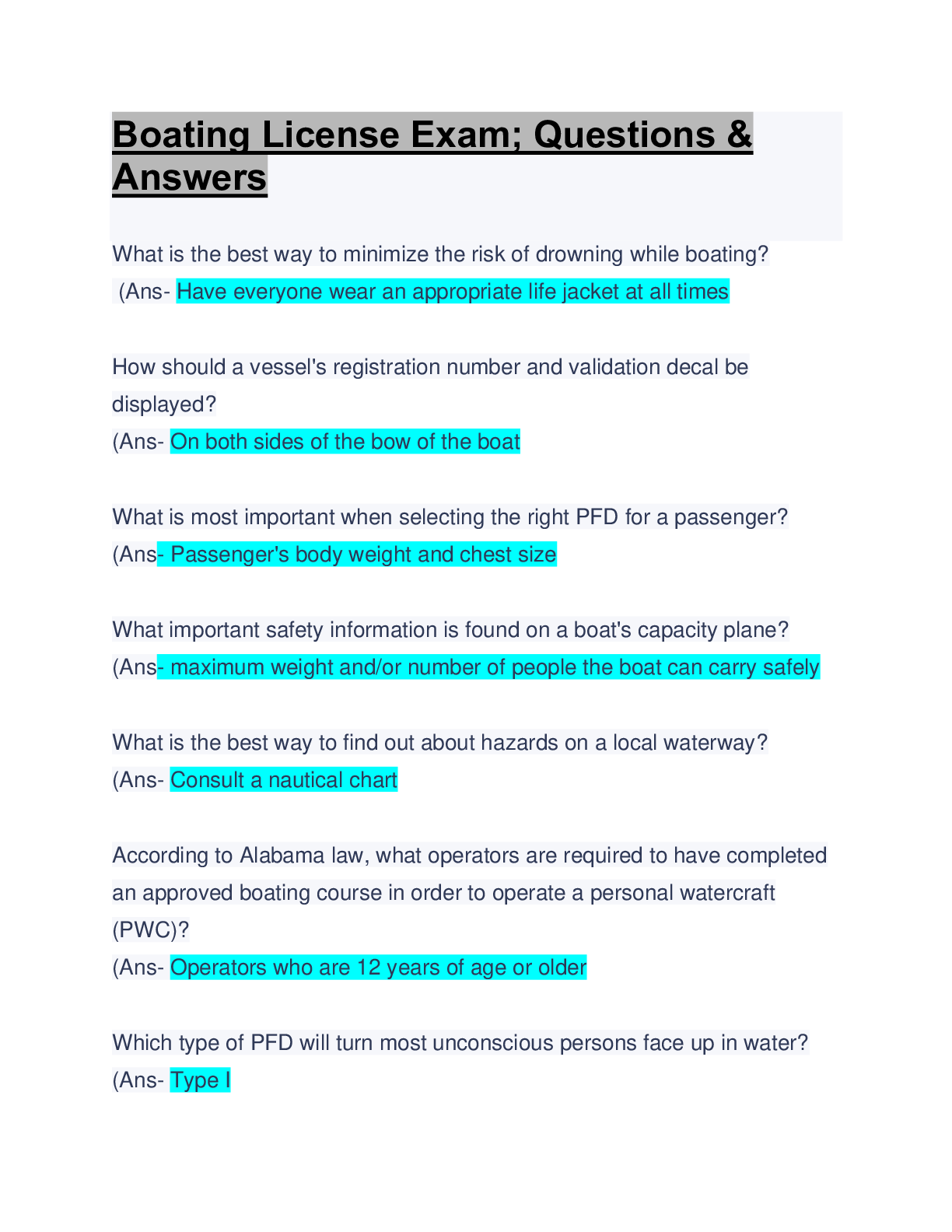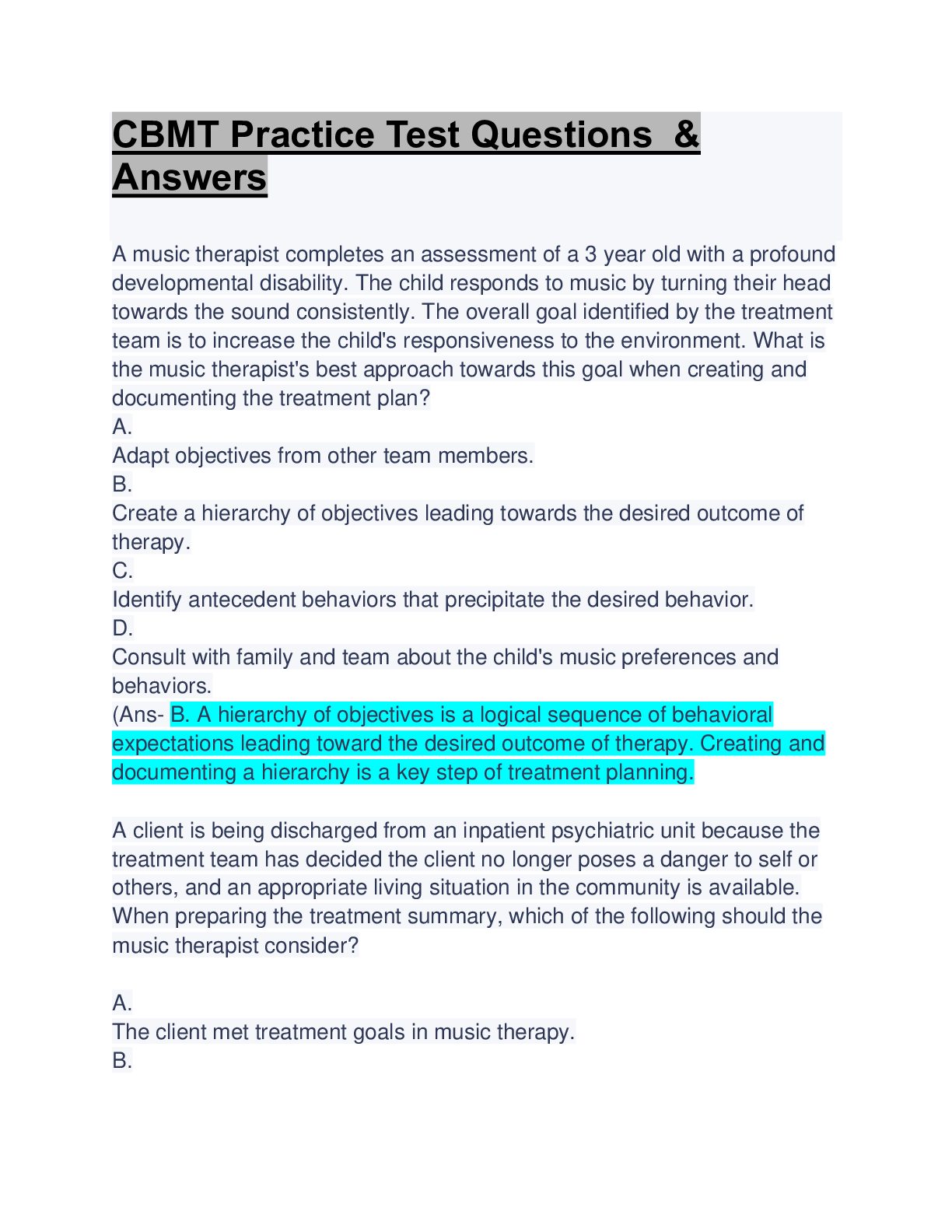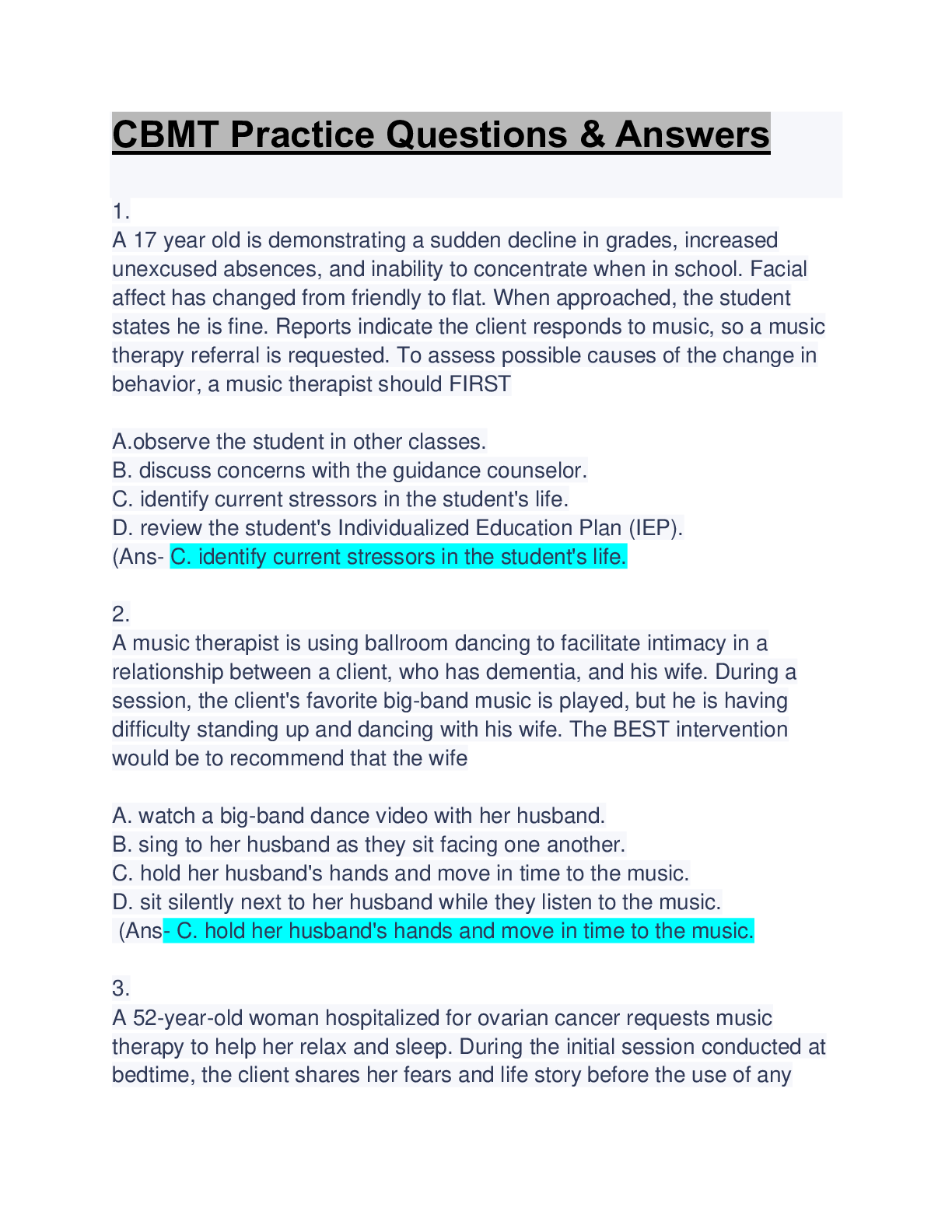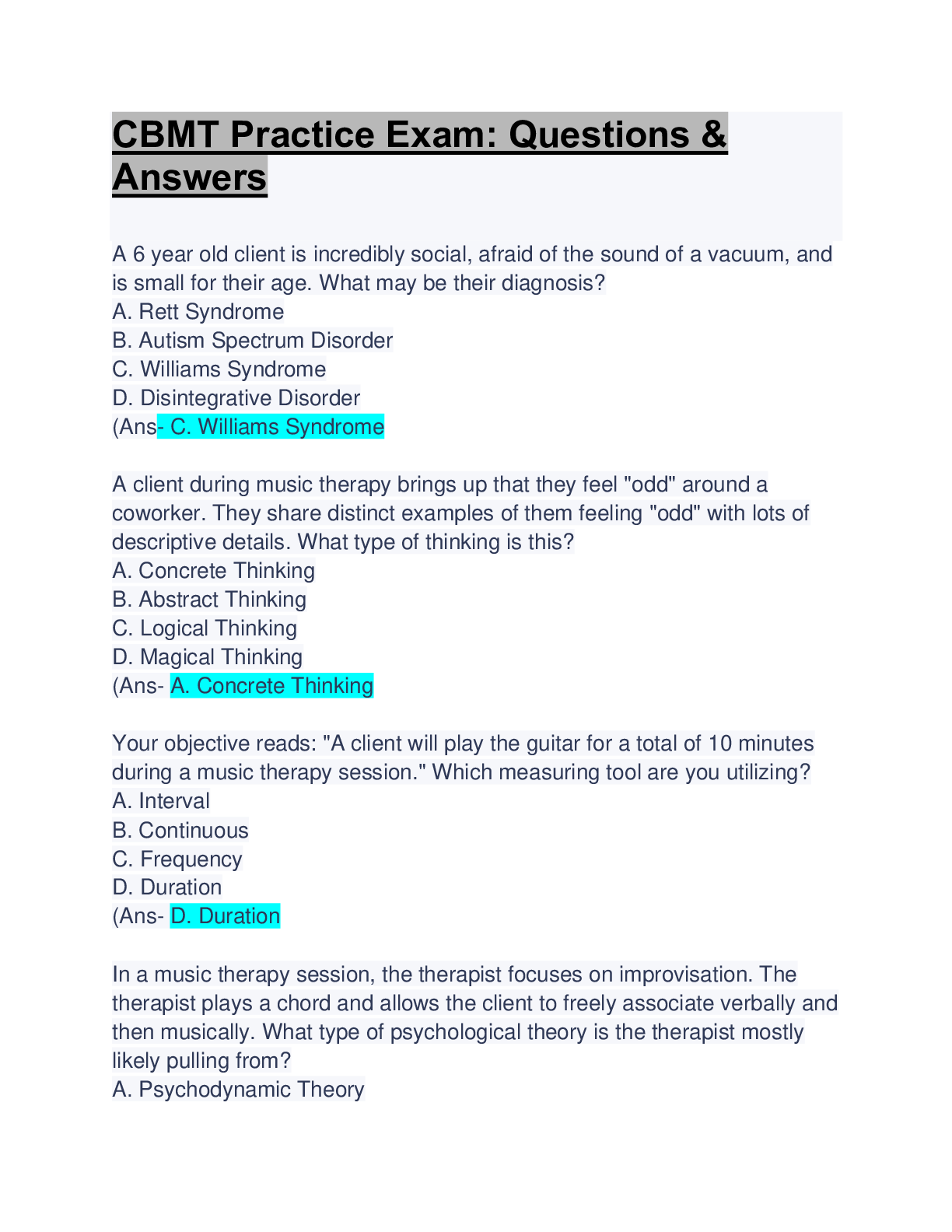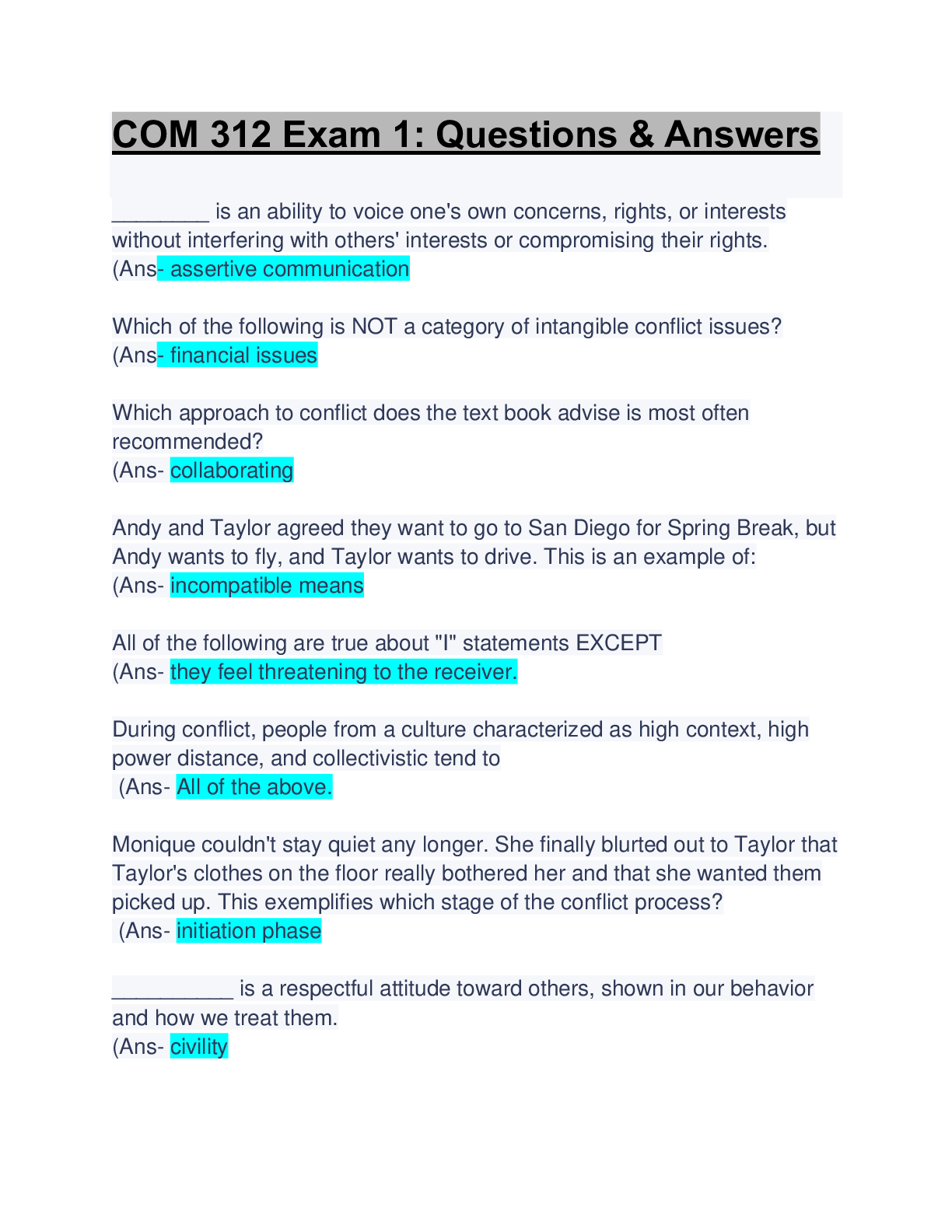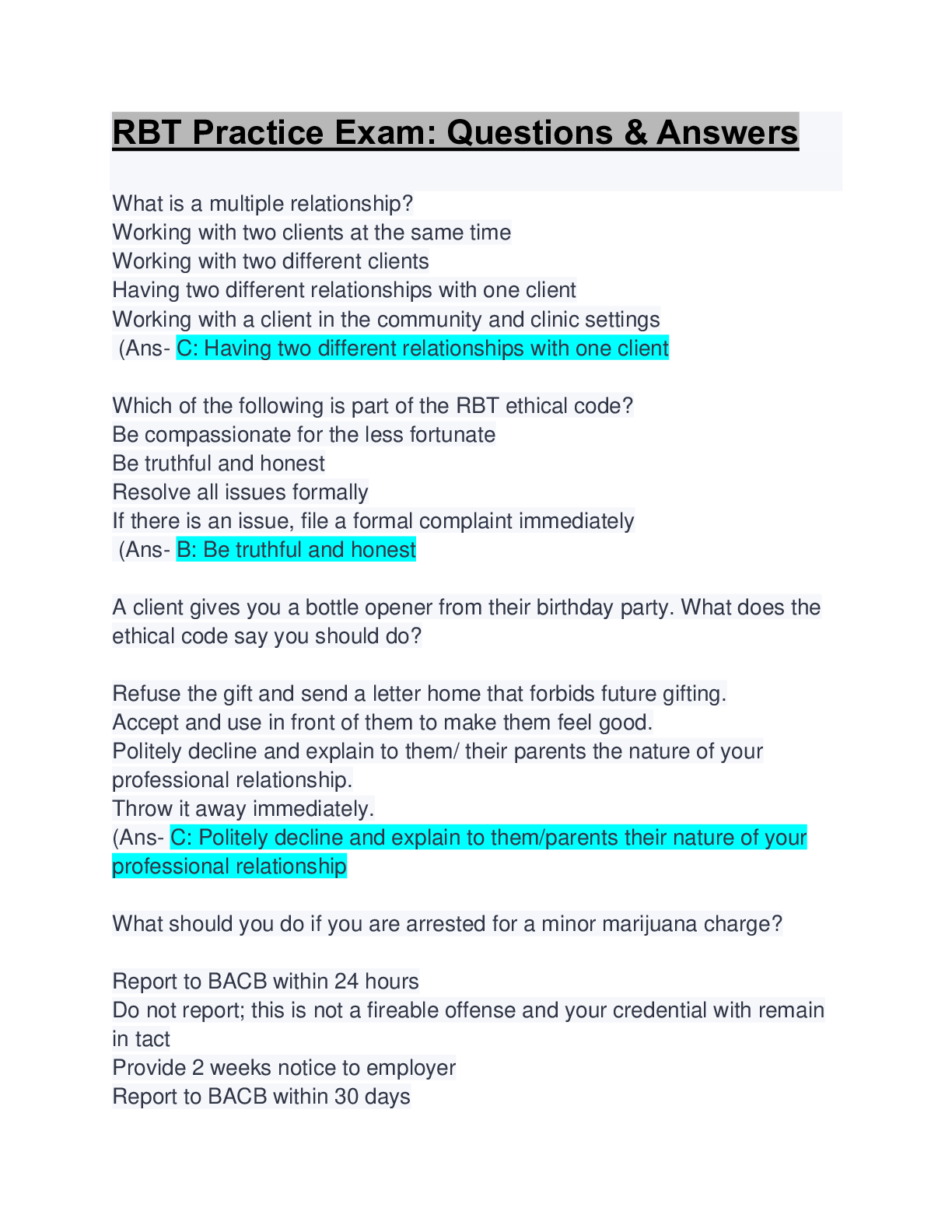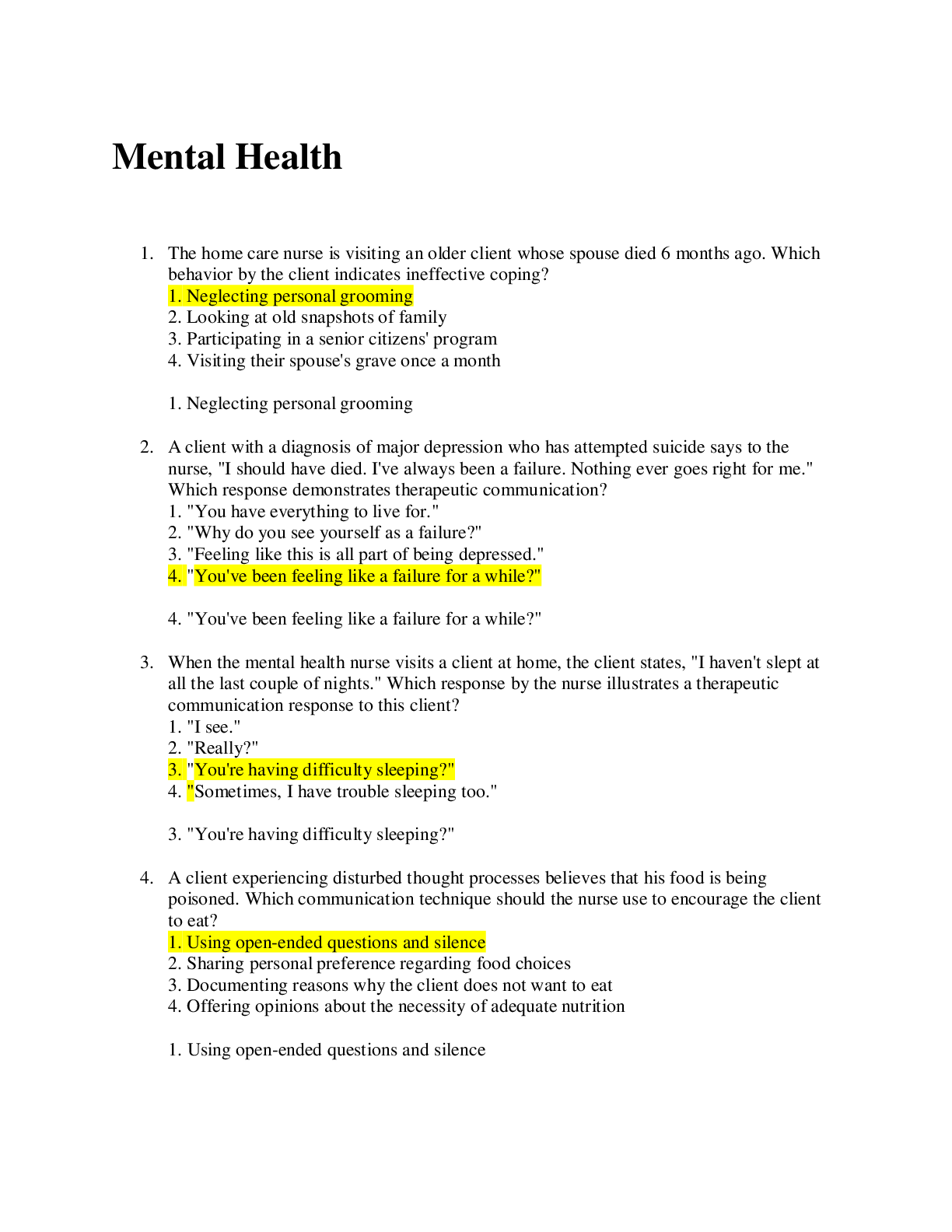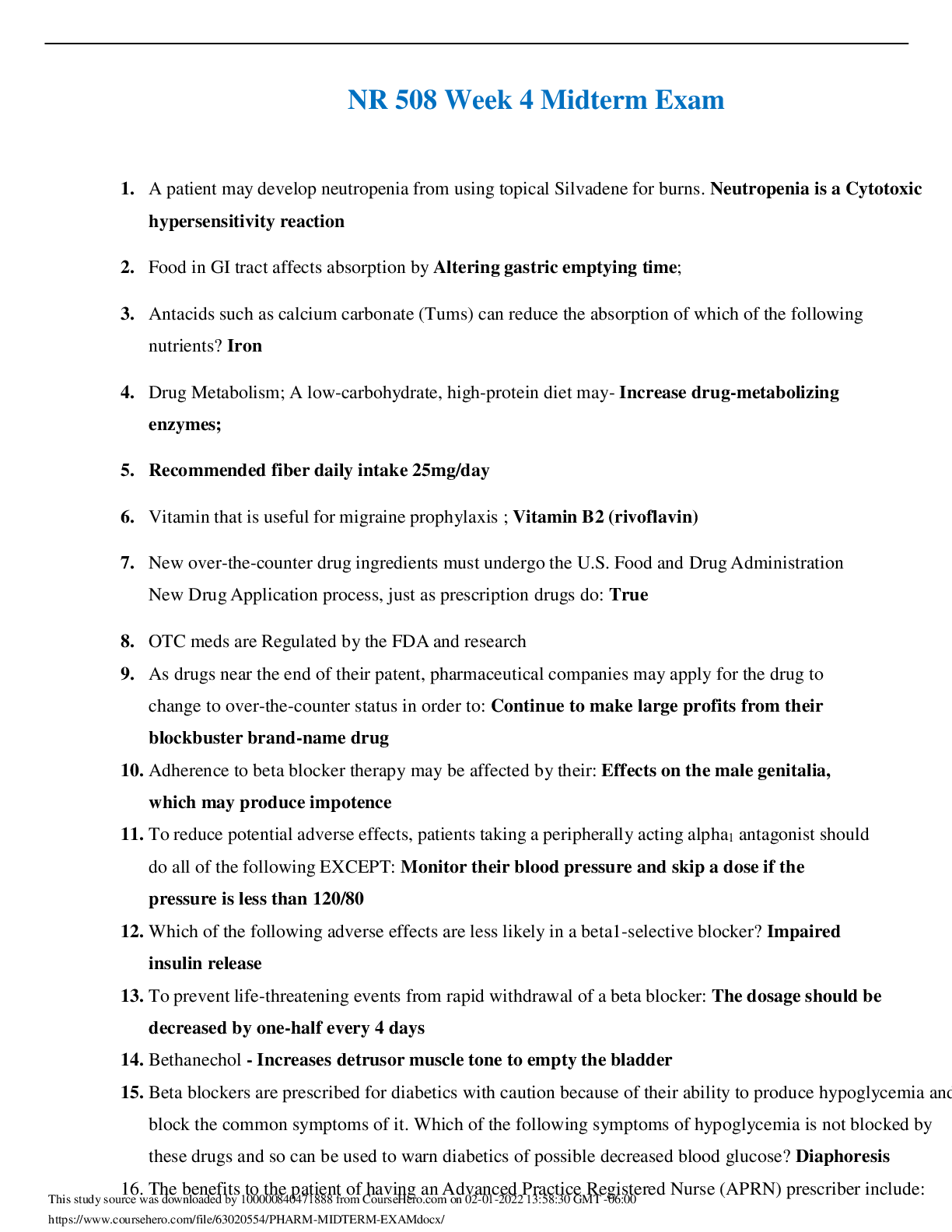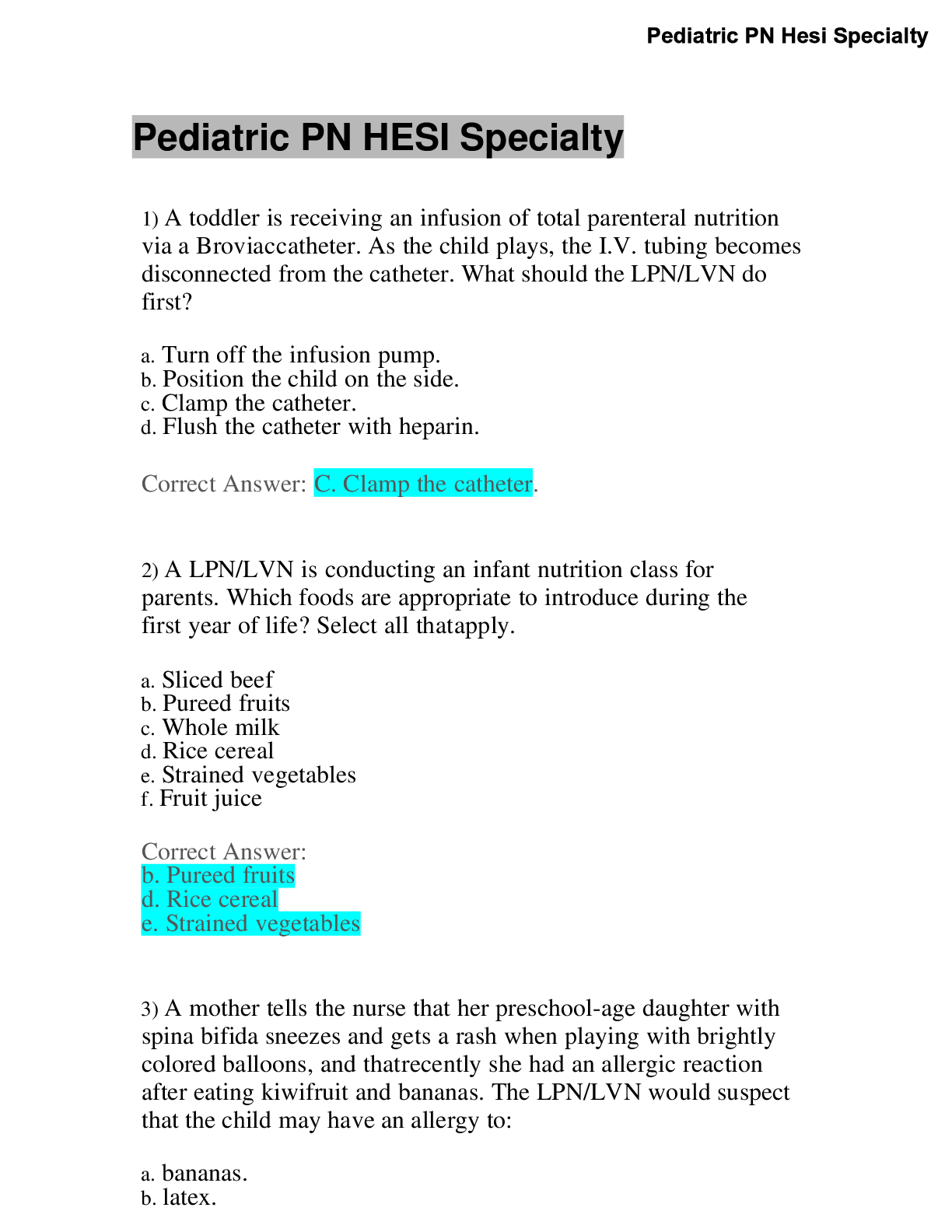CBMT Practice Questions & Answers: Latest Updated: A+ Guide Solutions
Document Content and Description Below
A 17 year old is demonstrating a sudden decline in grades, increased unexcused absences, and inability to concentrate when in school. Facial affect has changed from friendly to flat. When approached, ... the student states he is fine. Reports indicate the client responds to music, so a music therapy referral is requested. To assess possible causes of the change in behavior, a music therapist should FIRST A.observe the student in other classes. B. discuss concerns with the guidance counselor. C. identify current stressors in the student's life. D. review the student's Individualized Education Plan (IEP). (Ans- C. identify current stressors in the student's life. 2. A music therapist is using ballroom dancing to facilitate intimacy in a relationship between a client, who has dementia, and his wife. During a session, the client's favorite big-band music is played, but he is having difficulty standing up and dancing with his wife. The BEST intervention would be to recommend that the wife A. watch a big-band dance video with her husband. B. sing to her husband as they sit facing one another. C. hold her husband's hands and move in time to the music. D. sit silently next to her husband while they listen to the music. (Ans- C. hold her husband's hands and move in time to the music. 3. A 52-year-old woman hospitalized for ovarian cancer requests music therapy to help her relax and sleep. During the initial session conducted at bedtime, the client shares her fears and life story before the use of any music intervention. After validating the client's feelings, the BEST direction for the music therapist to take is to A. discuss favorite songs important to the client's life. B. improvise soft guitar music to help the client go to sleep. C. compose a song together reflecting the client's disclosure. D. close the session and bring the client's favorite music to follow-up visits. (Ans- B. improvise soft guitar music to help the client go to sleep. 4. A music therapist has been jointly treating a client with vascular dementia and the client's daughter, once a week for one hour. Recently, the client has become more withdrawn, presenting with a reduced emotional response and increased passivity. Despite changes, the daughter continues to encourage the client to be active and engaged, yet the client is agitated and combative. Which of the following is the music therapist's BEST response? A. Continue treatment using the music to address agitation and combativeness. B. Discontinue treatment as the client's passivity will increase with disease progression. C. Remove the daughter from the music therapy session immediately. D. Re-evaluate the session length and interventions used during music therapy sessions. (Ans- D. Re-evaluate the session length and interventions used during music therapy sessions. 5. When completing a behavioral assessment, information relating ONLY to behaviors observed, not interpretation, is considered A. subjective. B. irrelevant. C. prejudicial. D. objective. (Ans- D. objective. 6. A 7-year-old girl with a severe developmental disability is receiving music therapy in a residential setting. She is nonverbal and prone to be fearful and anxious in new situations. When brought into the therapy room for her first session, she actively resists and begins to cry. The music therapist, working in an improvisational model, might do which of the following? 1. Meet the child by playing music to express the intensity of her crying.2. Reflect the child's sound and breathing with careful musical phrasing.3. Comfort the child by holding and rocking her while singing soothing lyrics.4. Sing without words so the child hears another voice that corresponds to how she is feeling. A. 1, 2, and 3 only B. 1, 2, and 4 only C. 1, 3, and 4 only D. 2, 3, and 4 only (Ans- B. 1, 2, and 4 only 7. "Since her admission, Mary has spent most of her time in her room and has not participated in unit activities." Under which assessment domain would this statement MOST likely be found? A. psychosocial B. emotional C. communicative D. sensorimotor (Ans- A. psychosocial 8. When playing a familiar song with a young client, which of the following therapeutic exercises will MOST effectively increase sustained attention? A. altering note order B. varying key signature C. changing note duration D. modifying time signature (Ans- C. changing note duration 9. The last portion of a music therapy SOAP note discusses which of the following? A. progress summary B. physician's recommendations C. plan for treatment D. provider's assessment (Ans- C. plan for treatment 10. A song on the guitar in the key of C needs to be transposed to the key of Eb. Using first position fingering in the key of C, the therapist needs to place the capo on the A. 2nd fret. B. 3rd fret. C. 5th fret. D. 7th fret. (Ans- B. 3rd fret. 11. Evidence-based practice (EBP) principles require music therapists to take which of the following into account when planning treatment? A. best available research; patient characteristics, culture and preferences; and clinical expertise B. evidence of past treatment success; therapist knowledge and skills; and treatment length C. published music therapy program descriptions; therapist expertise; and assessment outcomes D. reviews of past research literature; patient history; and principle of beneficence (Ans- A. best available research; patient characteristics, culture and preferences; and clinical expertise 12. A music therapist working with a group of four children at an early intervention facility arrives to find the class is very excited, having just come in from the playground. Which of the following is the MOST important consideration when choosing a music selection to begin the session? A. a familiar song B. an unfamiliar song C. a song with an allegro tempo D. a song with an adagio tempo (Ans- C. a song with an allegro tempo 13. A music therapist with basic guitar skills wants to accompany a song written in the key of Ab major, using Ab, Db, and Eb7 chords. To allow for the use of all first position chords and only minimally affect the song's vocal register, the song should be transposed to the key of A. B major. B. D major. C. F major. D. G major. (Ans- D. G major. [Show More]
Last updated: 1 year ago
Preview 1 out of 47 pages
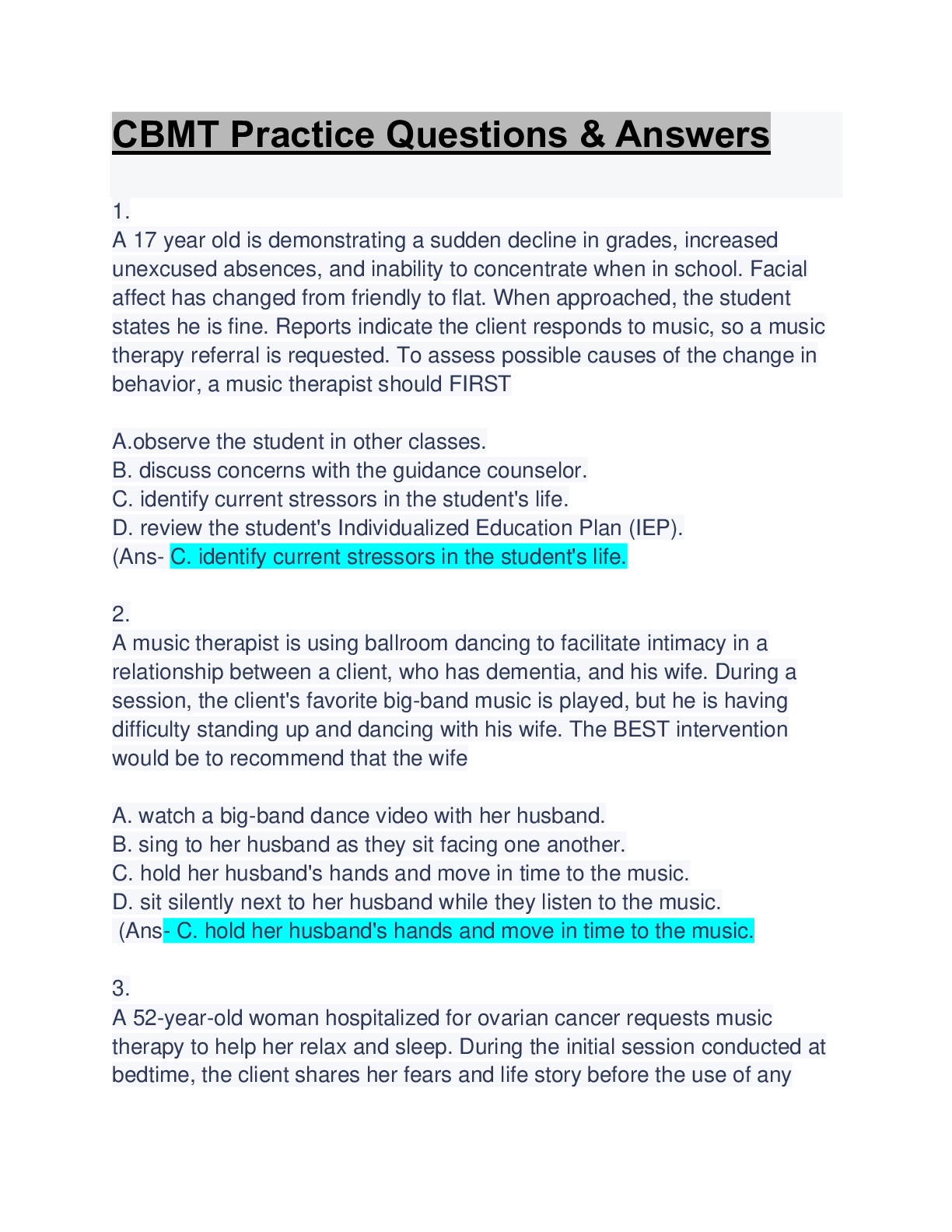
Reviews( 0 )
Document information
Connected school, study & course
About the document
Uploaded On
Apr 17, 2023
Number of pages
47
Written in
Additional information
This document has been written for:
Uploaded
Apr 17, 2023
Downloads
0
Views
42


